ACI 349-06Code Requirements for NuclearSafety-Related Concrete Structures(ACI 349-06) and CommentaryReported by ACI Committee 349�
American Concrete Institute®Advancing concrete knowledgeCode Requirements for Nuclear Safety-Related Concrete Structuresand CommentaryFirst PrintingSeptember 2007ISBN 978-0-87031-251-9Copyright by the American Concrete Institute, Farmington Hills, MI. All rights reserved. This materialmay not be reproduced or copied, in whole or part, in any printed, mechanical, electronic, film, or otherdistribution and storage media, without the written consent of ACI.The technical committees responsible for ACI committee reports and standards strive to avoid ambiguities,omissions, and errors in these documents. In spite of these efforts, the users of ACI documents occa-sionally find information or requirements that may be subject to more than one interpretation or may beincomplete or incorrect. Users who have suggestions for the improvement of ACI documents arerequested to contact ACI.ACI committee documents are intended for the use of individuals who are competent to evaluate thesignificance and limitations of its content and recommendations and who will accept responsibility for theapplication of the material it contains. Individuals who use this publication in any way assume all risk andaccept total responsibility for the application and use of this information.All information in this publication is provided “as is” without warranty of any kind, either express or implied,including but not limited to, the implied warranties of merchantability, fitness for a particular purpose ornon-infringement.ACI and its members disclaim liability for damages of any kind, including any special, indirect, incidental,or consequential damages, including without limitation, lost revenues or lost profits, which may resultfrom the use of this publication.It is the responsibility of the user of this document to establish health and safety practices appropriate tothe specific circumstances involved with its use. ACI does not make any representations with regard tohealth and safety issues and the use of this document. The user must determine the applicability of allregulatory limitations before applying the document and must comply with all applicable laws and regula-tions, including but not limited to, United States Occupational Safety and Health Administration (OSHA)health and safety standards.Order information: ACI documents are available in print, by download, on CD-ROM, through electronicsubscription, or reprint and may be obtained by contacting ACI.Most ACI standards and committee reports are gathered together in the annually revised ACI Manual ofConcrete Practice (MCP).American Concrete Institute38800 Country Club DriveFarmington Hills, MI 48331U.S.A.Phone:248-848-3700Fax:248-848-3701www.concrete.org�
ACI 349-06 supersedes ACI 349/349R-01, was adopted November 7, 2006, and waspublished September 2007.Copyright © 2007, American Concrete Institute.All rights reserved including rights of reproduction and use in any form or by anymeans, including the making of copies by any photo process, or by electronic ormechanical device, printed, written, or oral, or recording for sound or visual reproductionor for use in any knowledge or retrieval system or device, unless permission in writingis obtained from the copyright proprietors. 349-1ACI Committee Reports, Guides, Standard Practices, andCommentaries are intended for guidance in planning,designing, executing, and inspecting construction. Thisdocument is intended for the use of individuals who arecompetent to evaluate the significance and limitations of itscontent and recommendations and who will acceptresponsibility for the application of the material it contains.The American Concrete Institute disclaims any and allresponsibility for the stated principles. The Institute shall notbe liable for any loss or damage arising therefrom.Reference to this document shall not be made in contractdocuments. If items found in this document are desired by theArchitect/Engineer to be a part of the contract documents, theyshall be restated in mandatory language for incorporation bythe Architect/Engineer.Code Requirements for Nuclear Safety-Related Concrete Structures (ACI 349-06) and CommentaryAn ACI StandardReported by ACI Committee 349ACI 349-06This standard covers the proper design and construction of concrete structuresthat form part of a nuclear power plant and that have nuclear safety-relatedfunctions, but does not cover concrete reactor vessels and concrete containmentstructures (as defined by Joint ACI-ASME Committee 359).The structures covered by the Code include concrete structures inside andoutside the containment system.This Code may be referenced and applied subject to agreement betweenthe owner and the Regulatory Authority.All notation sections have been removed from the beginning of eachchapter and consolidated into one list in Chapter 2.The format of this Code is based on the “Building Code Requirements forStructural Concrete (ACI 318-05)” and incorporates recent revisions of thatstandard.The commentary, which is presented after the Code, discusses some of theconsiderations of ACI Committee 349 in developing “Code Requirements forNuclear Safety-Related Concrete Structures (ACI 349-06).” This informationis provided in the commentary because the Code is written as a legal documentand therefore cannot present background details or suggestions for carryingout its requirements.Keywords: admixtures; aggregates; anchorage (structural); authorityhaving jurisdiction (AHJ); beam-column frame; beams (supports); buildingcodes; cements; cold weather construction; columns (supports); combinedstress; composite construction (concrete and steel); composite construction(concrete to concrete); compressive strength; concrete construction;concretes; concrete cover; concrete slabs; construction joints; continuity(structural); cracking (fracturing); creep properties; curing; deep beams;deflection; drawings (drafting); earthquake-resistant structures; edgebeams; embedded service ducts; flexural strength; floors; folded plates;footings; formwork (construction); frames; hot weather construction;inspection; joists; load tests (structural); loads (forces); mixing; mixtureproportioning; modulus of elasticity; moments; nuclear power plants;nuclear reactor containments; nuclear reactor safety; nuclear reactors; pipecolumns; pipes (tubes); placing; precast concrete; prestressed concrete;prestressing steels; quality control; reinforced concrete; reinforcing steels;roofs; safety; serviceability; shear strength; shearwalls; shells (structuralforms); spans; specifications; splicing; strength; strength analysis; structuralanalysis; structural design; T-beams; temperature; torsion; walls; water;welded wire reinforcement.CONTENTSCODEChapter 1—General requirements, p. 349-61.1—Scope1.2—Drawings and specifications1.3—Inspection1.4—Approval of special systems of design or construction1.5—Quality assurance programHansraj G. AsharPartha S. GhosalJagadish R. JoshiBozidar StojadinovicRanjit L. BandyopadhyayHerman L. Graves IIIRichard E. KlingnerBarendra K. TalukdarPeter J. CarratoOrhan GurbuzNam-Ho Lee Donald T. WardRonald A. CookJames A. HammellDan J. NausAndrew S. WhittakerRolf EligehausenGunnar A. HarsteadDragos A. NutaAlbert Y. C. WongWerner FuchsChristopher HeinzRichard S. OrrCharles A. ZalesiakBranko GalunicCharles J. HookhamRonald J. JanowiakChair�
349-2ACI STANDARDChapter 2—Notation and definitions, p. 349-72.1—Code notation2.2—DefinitionsChapter 3—Materials, p. 349-173.1—Tests of materials3.2—Cements3.3—Aggregates3.4—Water3.5—Steel reinforcement3.6—Admixtures3.7—Storage and identification of materials3.8—Referenced standardsChapter 4—Durability requirements, p. 349-214.1—Water-cementitious material ratio4.2—Freezing and thawing exposures4.3—Sulfate exposures4.4—Corrosion protection of reinforcementChapter 5—Concrete quality, mixing, and placing, p. 349-225.1—General5.2—Selection of concrete proportions5.3—Proportioning on the basis of field experience or trialmixtures, or both5.4—Proportioning without field experience or trialmixtures5.5—Average compressive strength reduction5.6—Evaluation and acceptance of concrete5.7—Preparation of equipment and place of deposit5.8—Mixing5.9—Conveying5.10—Depositing5.11—Curing5.12—Cold weather requirements5.13—Hot weather requirementsChapter 6—Formwork, embedded pipes, and construction joints, p. 349-266.1—Design of formwork6.2—Removal of forms, shores, and reshoring6.3—Conduits and pipes embedded in concrete6.4—Construction jointsChapter 7—Details of reinforcement, p. 349-287.1—Standard hooks7.2—Minimum bend diameters7.3—Bending7.4—Surface conditions of reinforcement7.5—Placing reinforcement7.6—Spacing limits for reinforcement7.7—Concrete protection for reinforcement7.8—Special reinforcement details for columns7.9—Connections7.10—Lateral reinforcement for compression members7.11—Lateral reinforcement for flexural members7.12—Minimum reinforcement7.13—Requirements for structural integrityChapter 8—Analysis and design—general considerations, p. 349-328.1—Design methods8.2—Loading8.3—Methods of analysis8.4—Redistribution of negative moments in continuousflexural members8.5—Modulus of elasticity8.6—Stiffness8.7—Span length8.8—Columns8.9—Arrangement of live load8.10—T-beam construction8.11—Joist construction8.12—Separate floor finishChapter 9—Strength and serviceability requirements, p. 349-349.1—General9.2—Required strength9.3—Design strength9.4—Design strength for reinforcement9.5—Control of deflectionsChapter 10—Flexure and axial loads, p. 349-3710.1—Scope10.2—Design assumptions10.3—General principles and requirements10.4—Distance between lateral supports of flexuralmembers10.5—Minimum reinforcement of flexural members10.6—Distribution of flexural reinforcement in beams andone-way slabs10.7—Deep beams10.8—Design dimensions for compression members10.9—Limits for reinforcement of compression members10.10—Slenderness effects in compression members10.11—Magnified moments—general10.12—Magnified moments—nonsway frames10.13—Magnified moments—sway frames10.14—Axially loaded members supporting slab system10.15—Transmission of column loads through floorsystem10.16—Composite compression members10.17—Bearing strengthChapter 11—Shear and torsion, p. 349-4211.1—Shear strength11.2—Lightweight concrete11.3—Shear strength provided by concrete for non-prestressed members11.4—Shear strength provided by concrete for prestressedmembers11.5—Shear strength provided by shear reinforcement11.6—Design for torsion11.7—Shear-friction11.8—Deep beams11.9—Special provisions for brackets and corbels11.10—Special provisions for walls�
CODE REQUIREMENTS FOR NUCLEAR SAFETY-RELATED CONCRETE STRUCTURES349-311.11—Transfer of moments to columns11.12—Special provisions for slabs and footingsChapter 12—Development and splices of reinforcement, p. 349-5112.1—Development of reinforcement—general12.2—Development of deformed bars and deformed wirein tension12.3—Development of deformed bars and deformed wirein compression12.4—Development of bundled bars12.5—Development of standard hooks in tension12.6—Mechanical anchorage12.7—Development of welded deformed wire reinforce-ment in tension12.8—Development of welded plain wire reinforcementin tension12.9—Development of prestressing strand12.10—Development of flexural reinforcement—general12.11—Development of positive moment reinforcement12.12—Development of negative moment reinforcement12.13—Development of web reinforcement12.14—Splices of reinforcement—general12.15—Splices of deformed bars and deformed wire intension12.16—Splices of deformed bars in compression12.17—Special splice requirements for columns12.18—Splices of welded deformed wire reinforcement intension12.19—Splices of welded plain wire reinforcement intensionChapter 13—Two-way slab systems, p. 349-5613.1—Scope13.2—Definitions13.3—Slab reinforcement13.4—Openings in slab systems13.5—Design procedures13.6—Direct design method13.7—Equivalent frame methodChapter 14—Walls, p. 349-6214.1—Scope14.2—General14.3—Minimum reinforcement14.4—Walls designed as compression members14.5—Empirical design method14.6—Nonbearing walls14.7—Walls as grade beams14.8—Alternative design of slender wallsChapter 15—Footings, p. 349-6315.1—Scope15.2—Loads and reactions15.3—Footings supporting circular or regular polygon-shaped columns or pedestals15.4—Moment in footings15.5—Shear in footings15.6—Development of reinforcement in footings15.7—Minimum footing depth15.8—Transfer of force at base of column, wall, orreinforced pedestal15.9—Sloped or stepped footings15.10—Combined footings and matsChapter 16—Precast concrete, p. 349-6516.1—Scope16.2—General16.3—Distribution of forces among members16.4—Member design16.5—Structural integrity16.6—Connection and bearing design16.7—Items embedded after concrete placement16.8—Marking and identification16.9—Handling16.10—Strength evaluation of precast constructionChapter 17—Composite concrete flexural members, p. 349-6717.1—Scope17.2—General17.3—Shoring17.4—Vertical shear strength17.5—Horizontal shear strength17.6—Ties for horizontal shearChapter 18—Prestressed concrete, p. 349-6818.1—Scope18.2—General18.3—Design assumptions18.4—Serviceability requirements—flexural members18.5—Permissible stresses in prestressing steel18.6—Loss of prestress18.7—Flexural strength18.8—Limits for reinforcement of flexural members18.9—Minimum bonded reinforcement18.10—Statically indeterminate structures18.11—Compression members—combined flexure andaxial loads18.12—Slab systems18.13—Post-tensioned tendon anchorage zones18.14—Intentionally left blank18.15—Intentionally left blank18.16—Corrosion protection for unbonded tendons18.17—Post-tensioning ducts18.18—Grout for bonded tendons18.19—Protection for prestressing steel18.20—Application and measurement of prestressing force18.21—Post-tensioning anchorages and couplers18.22—External post-tensioningChapter 19—Shells, p. 349-7319.1—Scope19.2—General19.3—Design strength of materials19.4—Section design and reinforcement requirements19.5—Construction�
349-4ACI STANDARDChapter 20—Strength evaluation of existing structures, p. 349-7420.1—Strength evaluation—general20.2—Analytical investigations—general20.3—Load tests—general20.4—Load test procedure20.5—Loading criteria20.6—Acceptance criteria20.7—SafetyChapter 21—Provisions for seismic design,p. 349-7521.1—Definitions21.2—General requirements21.3—Flexural members of moment frames21.4—Moment frame members subjected to bending andaxial load21.5—Joints of moment frames21.6—Intentionally left blank21.7—Reinforced concrete structural walls and couplingbeams21.8—Intentionally left blank21.9—Structural diaphragms and trusses21.10—FoundationsAPPENDIXESAppendix A—Strut-and-tie models, p. 349-82A.1—DefinitionsA.2—Strut-and-tie model design procedureA.3—Strength of strutsA.4—Strength of tiesA.5—Strength of nodal zonesAppendix B—Intentionally left blank, p. 349-84Appendix C—Alternative load and strength- reduction factors, p. 349-84C.1—GeneralC.2—Required strengthC.3—Design strengthAppendix D—Anchoring to concrete, p. 349-85D.1—DefinitionsD.2—ScopeD.3—General requirementsD.4—General requirements for strength of anchorsD.5—Design requirements for tensile loadingD.6—Design requirements for shear loadingD.7—Interaction of tensile and shear forcesD.8—Required edge distances, spacings, and thicknessesto preclude splitting failureD.9—Installation of anchorsD.10—Structural plates, shapes, and specialty insertsD.11—Shear strength of embedded plates and shear lugsD.12—Grouted embedmentsAppendix E—Thermal considerations, p. 349-92E.1—ScopeE.2—DefinitionsE.3—General design requirementsE.4—Concrete temperaturesAppendix F—Special provisions for impulsive and impactive effects, p. 349-93F.1—ScopeF.2—Dynamic strength increaseF.3—DeformationF.4—Requirements to assure ductilityF.5—Shear strengthF.6—Impulsive effectsF.7—Impactive effectsF.8—Impactive and impulsive loadsAppendix G—SI metric equivalents of U.S. Customary Units, p. 349-96COMMENTARYIntroduction, p. 349-101Chapter R1—General requirements, p. 349-101R1.1—ScopeR1.2—Drawings and specificationsR1.3—InspectionR1.4—Approval of special systems of design or constructionR1.5—Quality assurance programChapter R2—Notation and definitions, p. 349-102R2.1—Commentary notationR2.2—DefinitionsChapter R3—Materials, p. 349-102R3.1—Tests of materialsR3.2—CementsR3.3—AggregatesR3.4—WaterR3.5—Steel reinforcementR3.6—AdmixturesR3.7—Storage and identification of materialsChapter R4—Durability requirements, p. 349-104R4.2—Freezing and thawing exposuresR4.3—Sulfate exposuresR4.4—Corrosion protection of reinforcementChapter R5—Concrete quality, mixing, and placing, p. 349-105R5.1—GeneralR5.3—Proportioning on the basis of field experience, ortrial mixtures, or bothR5.4—Proportioning without field experience or trialmixturesR5.6—Evaluation and acceptance of concreteR5.7—Preparation of equipment and place of depositR5.9—ConveyingR5.10—DepositingR5.11—CuringR5.12—Cold weather requirementsR5.13—Hot weather requirements�
CODE REQUIREMENTS FOR NUCLEAR SAFETY-RELATED CONCRETE STRUCTURES349-5Chapter R6—Formwork, embedded pipes, and construction joints, p. 349-108R6.1—Design of formworkR6.2—Removal of forms, shores, and reshoringR6.3—Conduits and pipes embedded in concreteR6.4—Construction jointsChapter R7—Details of reinforcement, p. 349-108R7.4—Surface conditions of reinforcementR7.12—Minimum reinforcementR7.13—Requirements for structural integrityChapter R8—Analysis and design—general considerations, p. 349-109R8.2—LoadingR8.3—Methods of analysisR8.5—Modulus of elasticityR8.11—Joist constructionChapter R9—Strength and serviceability requirements, p. 349-109R9.1—GeneralR9.2—Required strengthR9.3—Design strengthR9.4—Design strength for reinforcementR9.5—Control of deflectionsChapter R10—Flexure and axial loads, p. 349-113R10.6—Distribution of flexural reinforcement in beamsand one-way slabsChapter R11—Shear and torsion, p. 349-113R11.12—Special provisions for slabs and footingsChapter R12—Development and splices of reinforcement, p. 349-113R12.6—Mechanical anchorageR12.14—Splices of reinforcement—generalR12.15—Splices of deformed bars and deformed wire intensionChapter R13—Two-way slab systems, p. 349-114Chapter R14—Walls, p. 349-114R14.3—Minimum reinforcementChapter R15—Footings, p. 349-114Chapter R16—Precast concrete, p. 349-114Chapter R17—Composite concrete flexural members, p. 349-114Chapter R18—Prestressed concrete, p. 349-114Chapter R19—Shells, p. 349-114R19.1—ScopeR19.2—GeneralR19.4—Section design and reinforcement requirementsChapter 20—Strength evaluation of existing structures, p. 349-115R20.1—Strength evaluation—generalR20.2—Analytical investigations—generalR20.3—Load tests—generalR20.4—Load test procedureR20.5—Loading criteriaR20.6—Acceptance criteriaChapter R21—Provisions for seismic design,p. 349-116R21.1—DefinitionsR21.2—General requirementsR21.3—Flexural members of moment framesR21.4—Moment frame members subjected to bendingand axial loadR21.5—Joints of moment framesR21.6—Intentionally left blankR21.7—Reinforced concrete structural walls and couplingbeamsR21.8—Intentionally left blankR21.9—Structural diaphragms and trussesR21.10—FoundationsAPPENDIXESAppendix RA—Strut-and-tie models, p. 349-127Appendix RB—Intentionally left blank, p. 349-127Appendix RC—Alternative load and design strength-reduction factors, p. 349-127RC.1—GeneralRC.2—Required strengthRC.3—Design strengthAppendix RD—Anchoring to concrete, p. 349-128RD.1—DefinitionsRD.2—ScopeRD.3—General requirementsRD.4—General requirements for strength of anchorsRD.5—Design requirements for tensile loadingRD.6—Design requirements for shear loadingRD.7—Interaction of tensile and shear forcesRD.8—Required edge distances, spacings, and thicknessesto preclude splitting failureRD.9—Installation of anchorsRD.10—Structural plates, shapes, and specialty insertsRD.11—Shear strength of embedded plates and shear lugsAppendix RE—Thermal considerations, p. 349-141RE.1—ScopeRE.2—DefinitionsRE.3—General design requirementsRE.4—Concrete temperaturesAppendix RF—Special provisions for impulsive and impactive effects, p. 349-144RF.1—ScopeRF.2—Dynamic strength increaseRF.3—Deformation�
349-6ACI STANDARDRF.4—Requirements to assure ductilityRF.5—Shear strengthRF.6—Impulsive effectsRF.7—Impactive effectsRF.8—Impactive and impulsive loadsSummary of changes for 349-06 Code, p. 349-150CODECHAPTER 1—GENERAL REQUIREMENTS1.1—Scope1.1.1 This Code provides minimum requirements fordesign and construction of nuclear safety-related concretestructures and structural members for nuclear power generatingstations. Safety-related structures and structural memberssubject to this standard are those concrete structures thatsupport, house, or protect nuclear safety class systems orcomponent parts of nuclear safety class systems.Specifically excluded from this Code are those structurescovered by “Code for Concrete Reactor Vessels andContainments,” ASME Boiler and Pressure Vessel CodeSection III, Division 2, and pertinent General Requirements(ACI 359).This Code includes design and loading conditions that areunique to nuclear facilities, including shear design underbiaxial tension conditions, consideration of thermal andseismic effects, and impact and impulsive loads.For structural concrete, fc′ shall not be less than 2500 psi,unless otherwise specified.1.1.2 This Code shall govern in all matters pertaining todesign and construction of reinforced concrete structures, asdefined in 1.1.1, except wherever this Code is in conflict withthe specific provisions of the authority having jurisdiction(AHJ).1.1.3 This Code shall govern in all matters pertaining todesign, construction, and material properties wherever thisCode is in conflict with requirements contained in otherstandards referenced in this Code.1.1.4 For special structures, such as arches, tanks,reservoirs, bins and silos, blast-resistant structures, andchimneys, provisions of this Code shall govern whereapplicable.1.1.5 Intentionally left blank.1.1.6 Intentionally left blank.1.1.7 Concrete on steel form deck1.1.7.1 Design and construction of structural concreteslabs cast on stay-in-place, noncomposite steel form deck aregoverned by this Code.1.1.7.2 This Code does not govern the design of structuralconcrete slabs cast on stay-in-place, composite steel form deck.Concrete used in the construction of such slabs shall be governedby Chapters 1 through 7 of this Code, where applicable.1.1.8 Special provisions for earthquake resistance—Provisions of Chapter 21 shall be satisfied. See 21.2.1.1.2—Drawings and specifications1.2.1 Copies of design drawings, typical details, andspecifications for all structural concrete construction shallbear the seal of a licensed engineer. These drawings(including supplementary drawings to generate the as-builtcondition), typical details, and specifications shall beretained by the owner, or his designee, as a permanent recordfor the life of the structure. As a minimum, these drawings,details, and specifications together shall show:(a)Name and date of issue of Code and supplement towhich design conforms;(b)Live load and other loads used in design;(c)Specified compressive strength of concrete at statedages or stages of construction for which each part ofstructure is designed;(d)Specified strength or grade of reinforcement;(e)Size and location of all structural members, reinforcement,and anchors;(f)Provision for dimensional changes resulting from creep,shrinkage, and temperature;(g)Magnitude and location of prestressing forces;(h)Anchorage length of reinforcement and location andlength of lap splices;(i)Type and location of mechanical and welded splices ofreinforcement;(j)Details and location of all contraction or isolation joints;(k)Minimum concrete compressive strength at time ofpost tensioning;(l)Stressing sequence for post-tensioning tendons;(m)Statement if slab-on-ground is designed as a structuraldiaphragm, see 21.10.3.4.1.2.2 Calculations pertinent to design and the basis ofdesign (including the results of model analysis, if any) shallbe retained by the owner or his designee, as a permanentrecord for the life of the structure. Accompanying thesecalculations shall be a statement of the applicable design andanalysis methods. When computer programs are used,design assumptions and identified input and output data maybe retained instead of calculations. Model analysis shall bepermitted to supplement calculations.1.3—Inspection1.3.1 The owner is responsible for the inspection ofconcrete construction throughout all work stages. Theowner shall require compliance with design drawings andspecifications. The owner shall also keep records required forquality assurance and traceability of construction, fabrication,material procurement, manufacture, or installation.1.3.2 The owner shall be responsible for designating therecords to be maintained and the duration of retention.Records pertinent to plant modifications or revisions, in-service inspections, and durability and performance ofstructures shall be maintained for the life of the plant. Theowner shall be responsible for continued maintenance of therecords. The records shall be maintained at the power plantsite, or at other locations as determined by the owner. As aminimum, the following installation/construction recordsshall be considered for lifetime retention:(a)Check-off sheets for tendon, reinforcing steel, andanchor installation;(b)Concrete cylinder test reports and charts;�
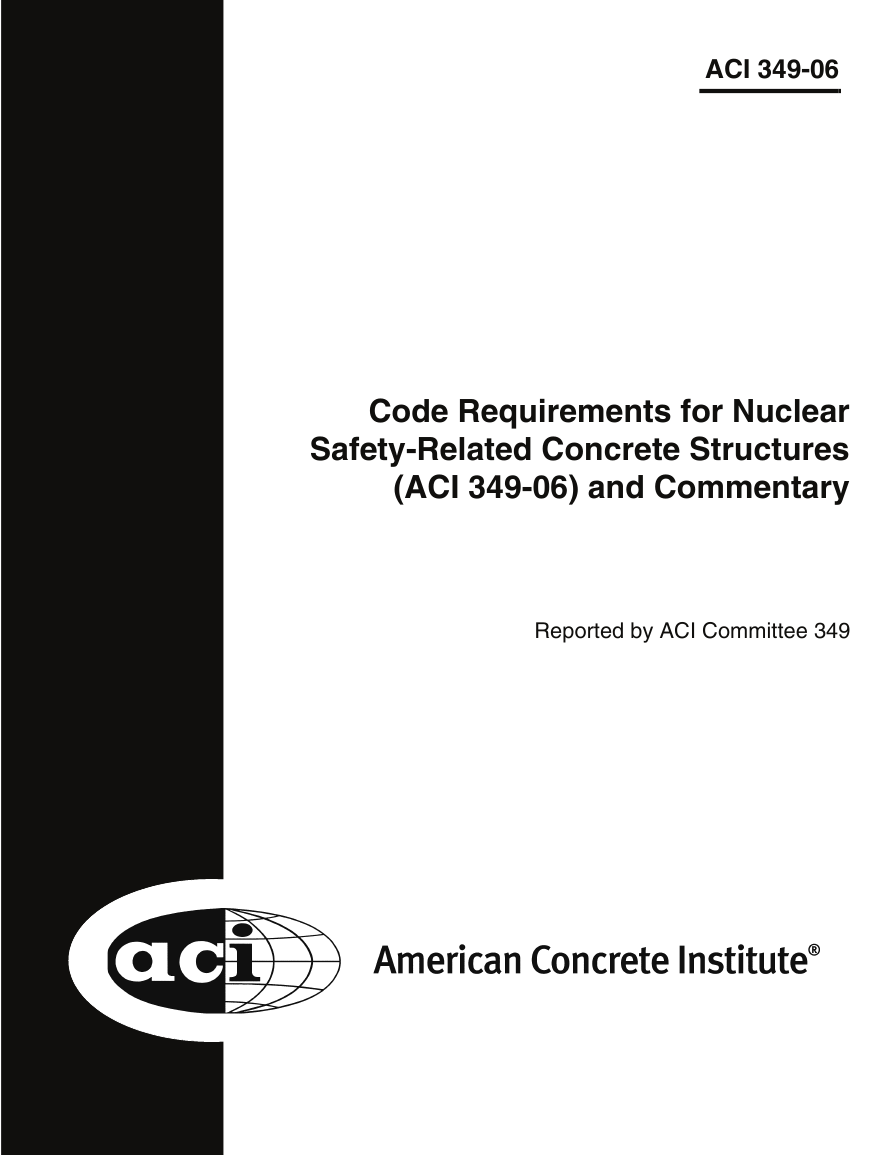
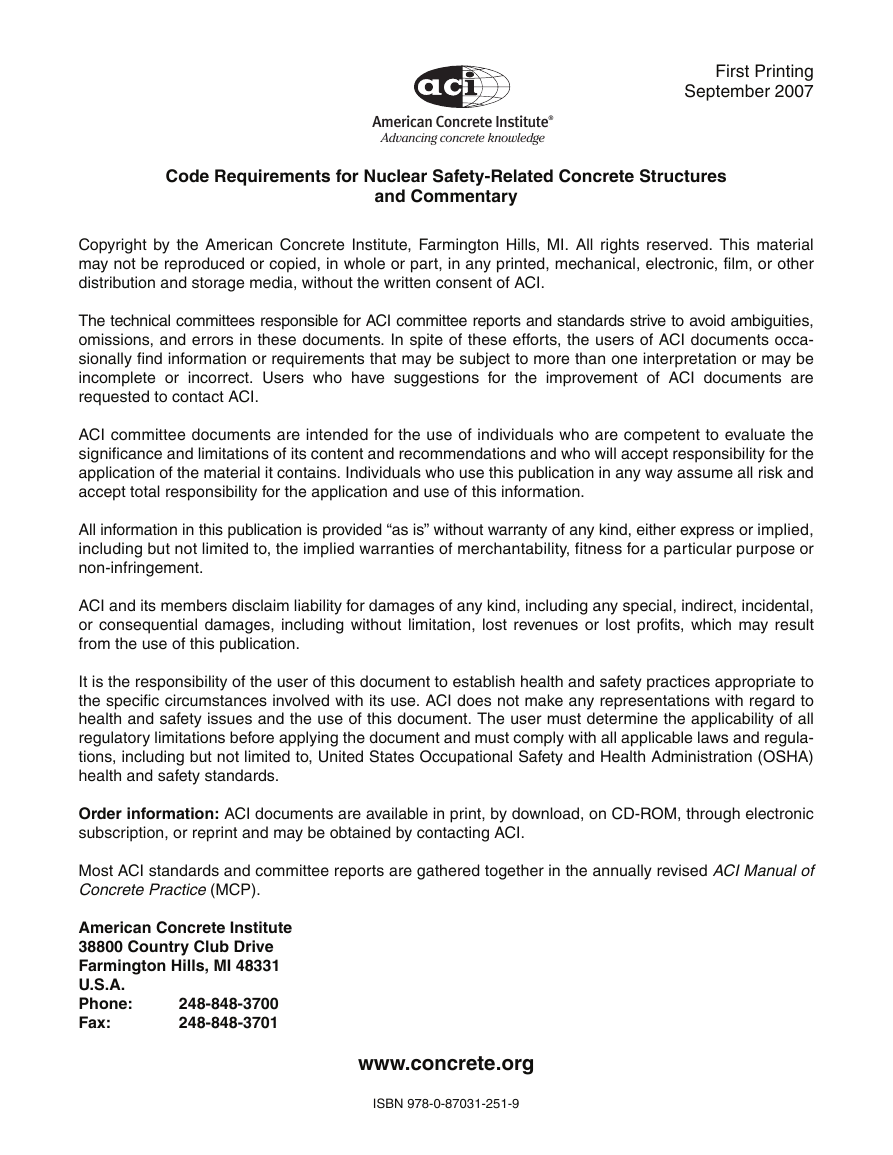

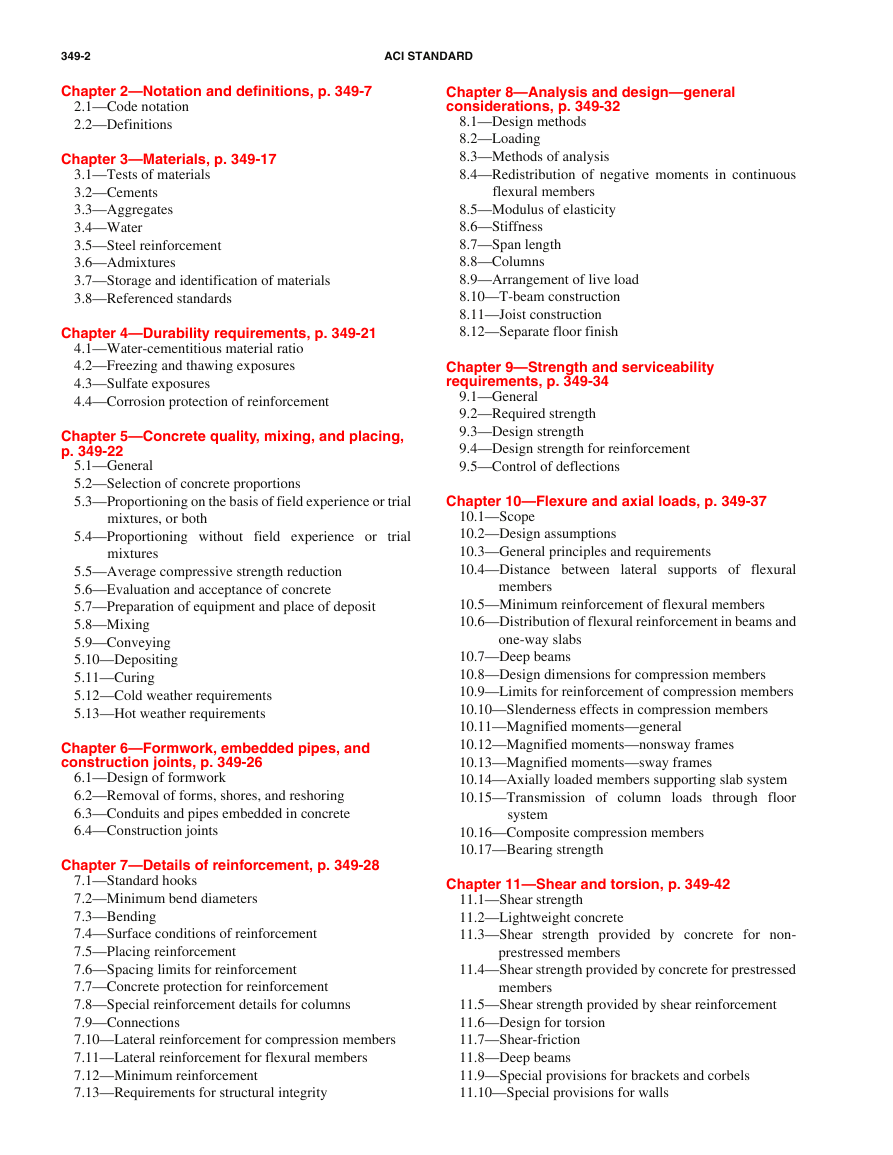
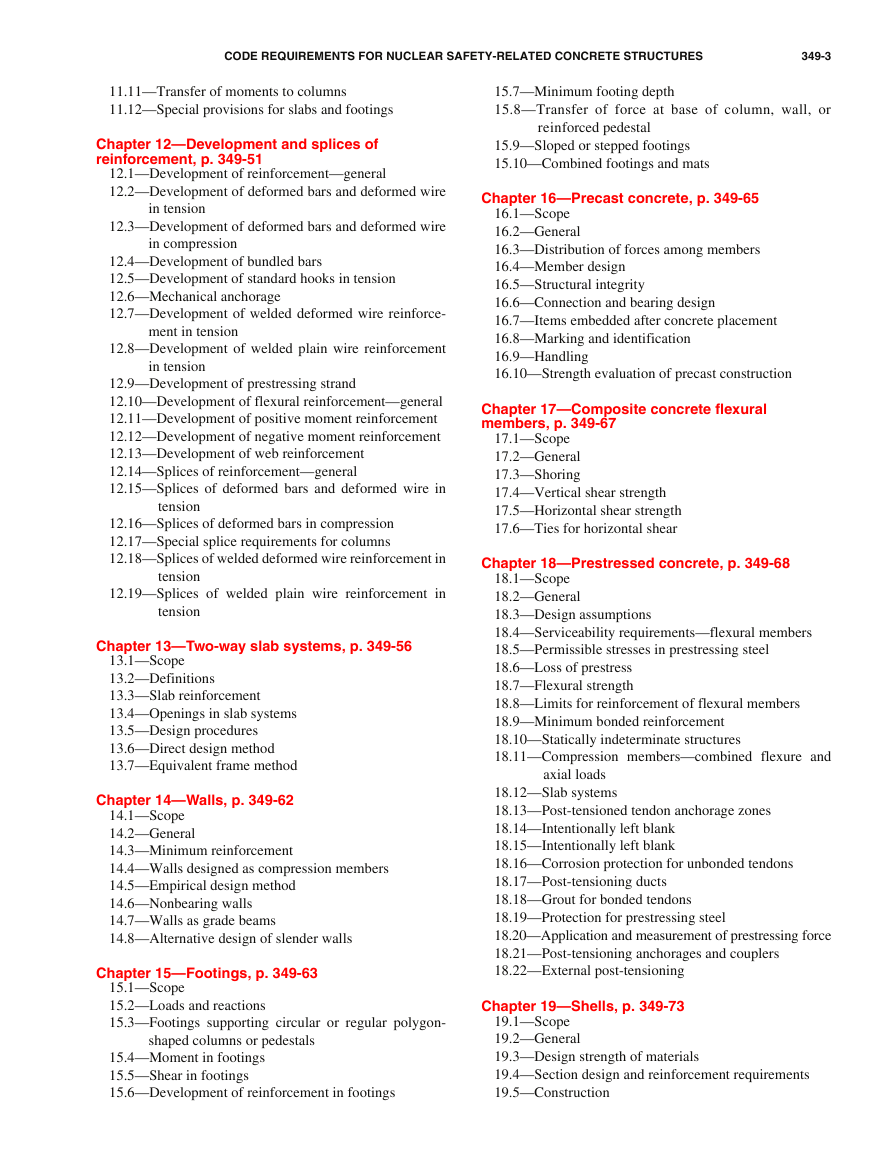
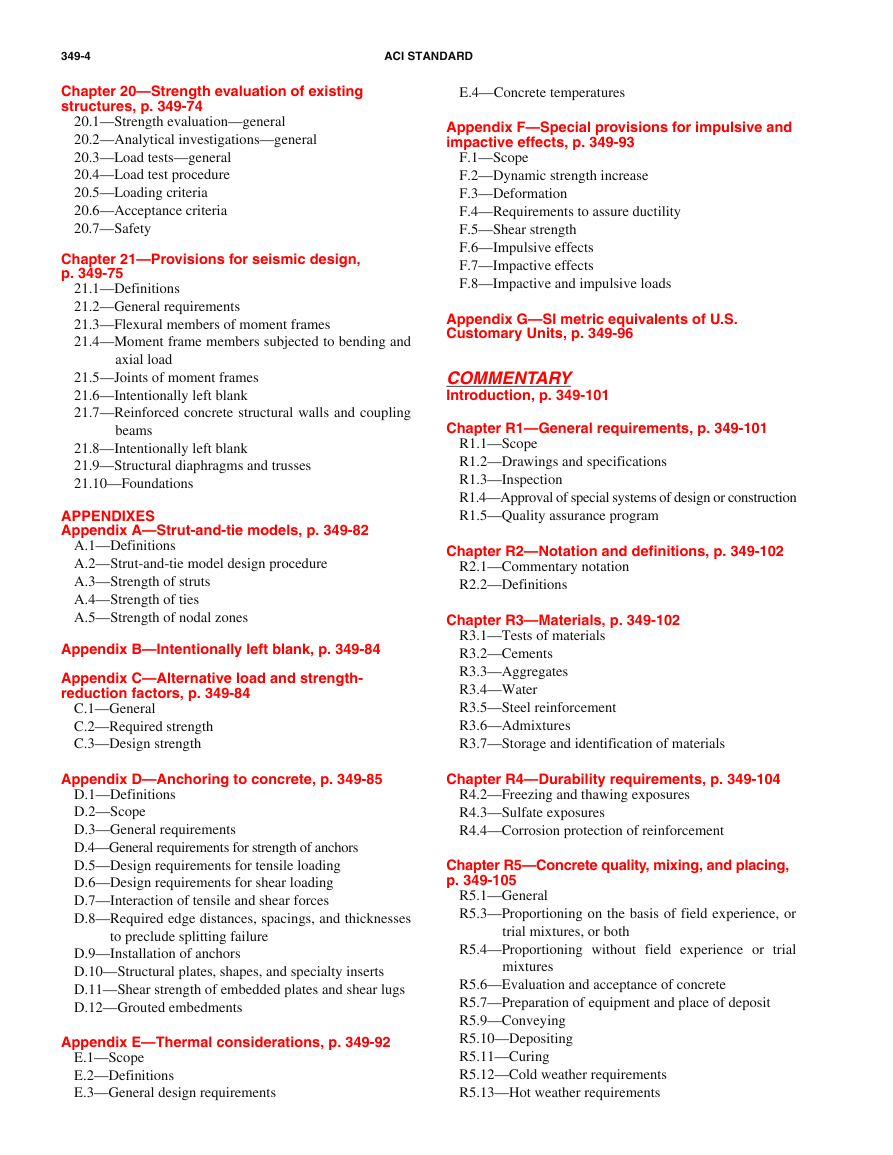

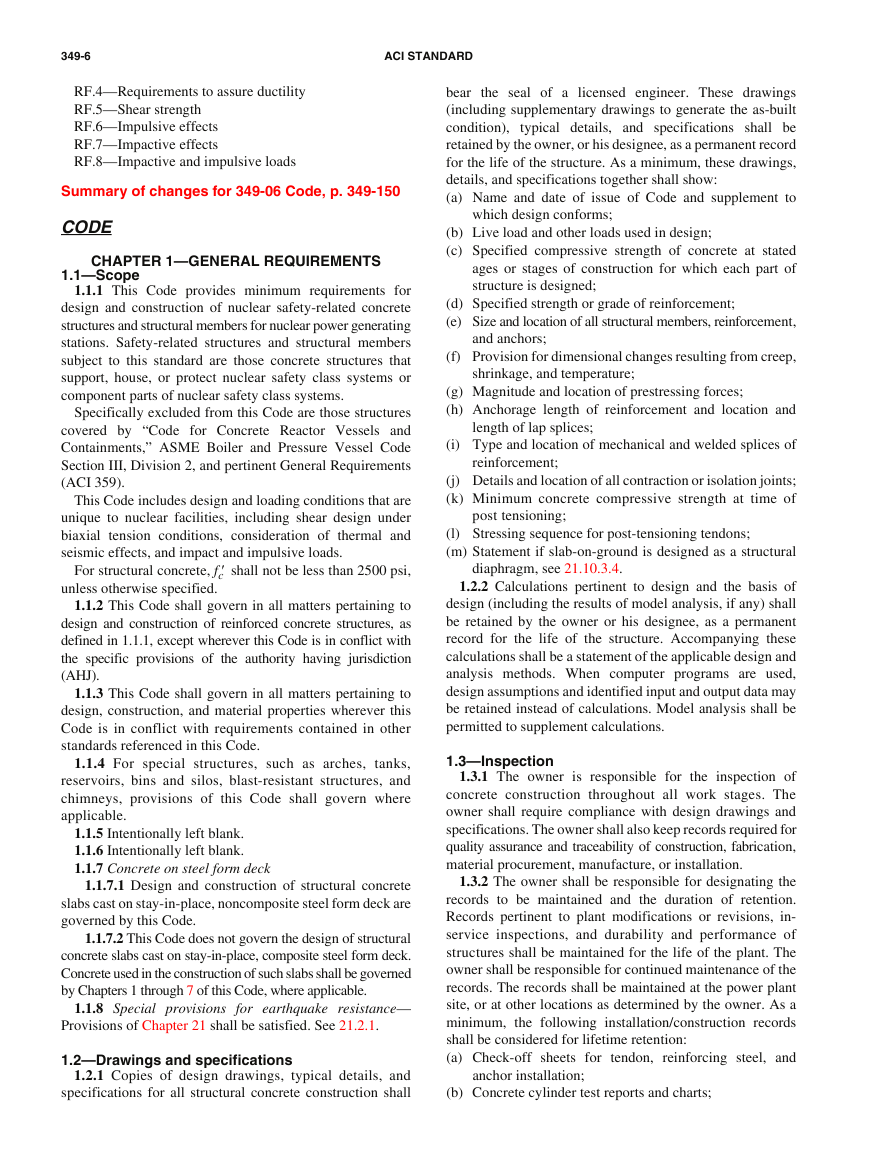








 2023年江西萍乡中考道德与法治真题及答案.doc
2023年江西萍乡中考道德与法治真题及答案.doc 2012年重庆南川中考生物真题及答案.doc
2012年重庆南川中考生物真题及答案.doc 2013年江西师范大学地理学综合及文艺理论基础考研真题.doc
2013年江西师范大学地理学综合及文艺理论基础考研真题.doc 2020年四川甘孜小升初语文真题及答案I卷.doc
2020年四川甘孜小升初语文真题及答案I卷.doc 2020年注册岩土工程师专业基础考试真题及答案.doc
2020年注册岩土工程师专业基础考试真题及答案.doc 2023-2024学年福建省厦门市九年级上学期数学月考试题及答案.doc
2023-2024学年福建省厦门市九年级上学期数学月考试题及答案.doc 2021-2022学年辽宁省沈阳市大东区九年级上学期语文期末试题及答案.doc
2021-2022学年辽宁省沈阳市大东区九年级上学期语文期末试题及答案.doc 2022-2023学年北京东城区初三第一学期物理期末试卷及答案.doc
2022-2023学年北京东城区初三第一学期物理期末试卷及答案.doc 2018上半年江西教师资格初中地理学科知识与教学能力真题及答案.doc
2018上半年江西教师资格初中地理学科知识与教学能力真题及答案.doc 2012年河北国家公务员申论考试真题及答案-省级.doc
2012年河北国家公务员申论考试真题及答案-省级.doc 2020-2021学年江苏省扬州市江都区邵樊片九年级上学期数学第一次质量检测试题及答案.doc
2020-2021学年江苏省扬州市江都区邵樊片九年级上学期数学第一次质量检测试题及答案.doc 2022下半年黑龙江教师资格证中学综合素质真题及答案.doc
2022下半年黑龙江教师资格证中学综合素质真题及答案.doc